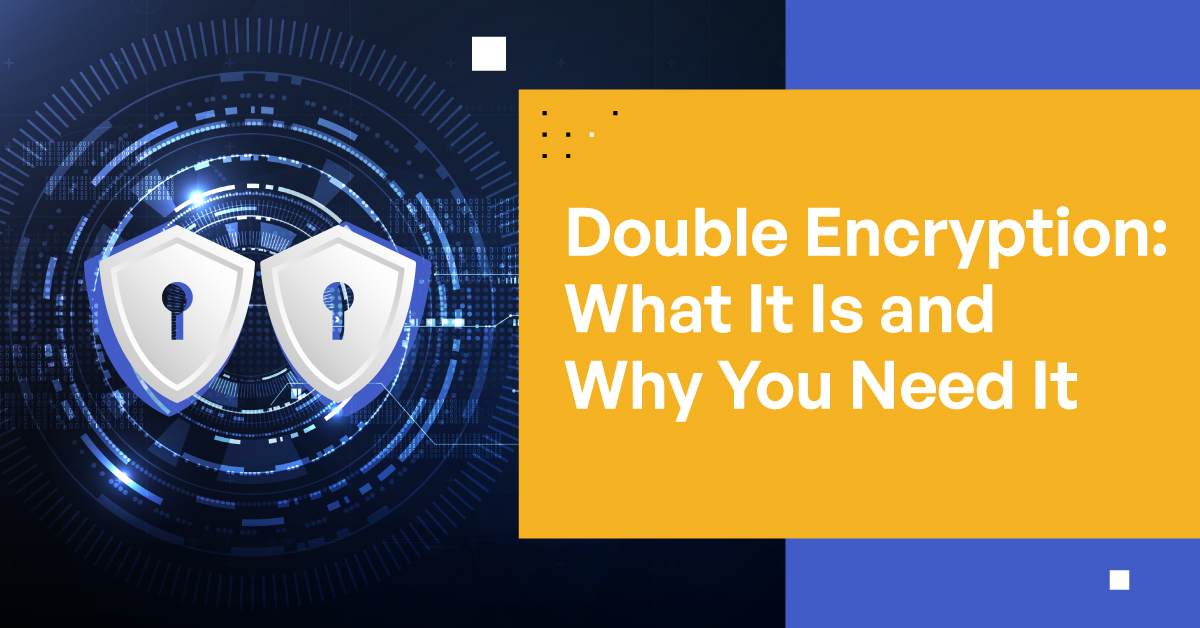What Is Double Encryption? Your Complete Guide to Enhanced Data Security
As technology advances, so do the methods used by cybercriminals and rogue nation-states to gain unauthorized access to sensitive information. With cyber hackers becoming more sophisticated in their attacks, a single layer of encryption is no longer sufficient to keep your data safe. That’s where double encryption becomes essential for modern data protection strategies.

Understanding Double Encryption: Definition and Importance
Double encryption is a security method that protects data by encrypting it twice using two separate encryption techniques. This process creates multiple layers of protection for emails, files, and digital communications, making unauthorized access significantly more difficult even if one encryption layer is compromised.
How Double Encryption Works: The Two-Layer Security Process
Double encryption employs a two-step process that provides superior protection compared to standard single-layer encryption methods:
The Outer Layer: First Line of Defense
The first layer (outer layer) encrypts files and email communications using powerful encryption algorithms such as:
- AES-256 encryption
- TLS 1.2+ protocol
- Other industry-standard encryption methods
This initial encryption transforms your original data into an unreadable format, creating the primary barrier against unauthorized access attempts.
The Inner Layer: Secondary Protection
The second encryption layer takes the already-encrypted data and encrypts it again using a different algorithm. This dual-layer approach requires sequential decryption to access the original data, creating a significantly stronger security posture for sensitive information.
In a typical double encryption process:
- File or email data receives initial encryption using the first encryption key
- The encrypted data undergoes a second encryption with a different encryption key
- The recipient uses corresponding decryption keys in the correct sequence to access the original content
Key Benefits of Double Encryption for Data Security
Implementing double encryption provides several significant advantages for organizations and individuals concerned with data security:
Enhanced Security Against Advanced Threats
The primary benefit of double encryption is dramatically improved security. By requiring attackers to break through two distinct encryption layers, double encryption significantly reduces the likelihood of unauthorized access to sensitive data.
Protection Against Sophisticated Attack Methods
Double encryption specifically helps defend against:
- Keylogging attacks
- Brute force attacks
- Man in the middle (MITM) attacks
- Volume-level security breaches
Improved Privacy for Sensitive Communications
For organizations handling confidential information like personally identifiable and protected health information (PII/PHI) and intellectual property (IP), double encryption ensures data remains private and secure even when transmitted over potentially vulnerable channels or stored in cloud environments.
Types of Double Encryption Methods
There are three primary approaches to implementing double encryption:
Symmetric-Key Double Encryption
Symmetric encryption uses identical keys for both encoding and decoding data. In double encryption implementations, symmetric methods often combine with hashing algorithms to provide additional protection. This approach typically offers the fastest processing while maintaining strong security.
Asymmetric-Key Double Encryption
Asymmetric encryption uses different keys—a public key for encoding and a private key for decoding. When implemented as part of a double encryption strategy, asymmetric methods often work alongside symmetric encryption to create extremely resilient security. This approach is particularly valuable for secure communications between parties.
Hashing and Salting in Double Encryption
The hashing and salting process creates unique cryptographic signatures or “fingerprints” for data. In double encryption implementations, these signatures verify data authenticity and provide an additional verification layer beyond the base encryption.
Best Practices for Implementing Double Encryption
To maximize the effectiveness of double encryption systems, organizations should follow these security practices:
Use Strong, Unique Encryption Keys
Implement different strong passwords and encryption keys for each layer of encryption. Using the same key for both layers defeats much of the purpose of double encryption and increases vulnerability to brute-force attacks.
Combine Different Encryption Algorithms
For maximum security, use different encryption algorithms for each layer rather than applying the same algorithm twice. This approach ensures that even if one algorithm is compromised, the second remains effective.
Implement Secure Key Management
Store encryption keys securely using:
- Hardware security modules
- Key management systems
- Secure offline storage when appropriate
Regularly Update Encryption Methods
Keep all encryption software and methods updated to protect against newly discovered vulnerabilities and ensure compliance with current security standards.
Limit Access to Sensitive Data
Restrict access to double-encrypted data to only authorized users with legitimate business needs, reducing the overall attack surface.
Challenges of Double Encryption Implementation
While double encryption provides significant security benefits, organizations should be aware of potential challenges:
Double Encryption Performance Considerations
The process of encrypting data twice requires additional computing resources and can sometimes impact system performance. However, with modern systems, this impact is typically minimal compared to the security benefits gained.
Integrating Double Encryption with Existing Systems
Double encryption may require modifications to existing security infrastructure. Organizations should carefully plan implementation to ensure compatibility with current systems and workflows.
Double Encryption in Enterprise Security Solutions
Many enterprise security platforms now incorporate double encryption as a standard feature. For example, some private content networks use double encryption by:
- Encrypting each file with a unique strong key at the file level
- Adding a second encryption layer with a different strong key at the disk-volume level
- Encrypting all keys when stored
- Using administrator-generated super keys for the encryption of stored keys
This comprehensive approach ensures maximum protection for sensitive content across numerous communication channels—email, file sharing, SFTP, managed file transfer (MFT), web forms, and APIs.
Kiteworks’ Private Data Network Uses Double Encryption
Double encryption is a powerful security technique that provides an extra layer of protection against cyberattacks and unauthorized access to sends, shares, receives, and secures of sensitive information. Organizations seeking to secure their sensitive content communications can benefit from the Kiteworks Private Data Network that uses double encryption. Kiteworks encrypts each piece of content with a unique, strong key at the file level and with a different strong key at the disk-level volume. This ensures that each file is double encrypted. Further, file keys, volume keys, and other intermediate keys are encrypted when stored.
In addition, Kiteworks uses a passphrase entered by an administrator to generate a super key it uses in the encryption of all stored keys. Thus, when an administrator rotates the passphrase on a regular basis, as recommended, the process is quick and efficient because only the keys need to be re-encrypted and not all content.
Organizations that want to see how the Kiteworks Private Data Network employs double encryption across numerous communication channels, including Kiteworks secure email, Kiteworks secure file sharing, secure MFT, secure virtual data rooms, Kiteworks secure web forms, and Kiteworks SFTP can schedule a custom demo today.
Frequently Asked Questions
Double encryption applies two separate encryption layers using different algorithms and keys, while regular encryption uses only a single encryption layer. The additional layer provided by double encryption significantly increases security and protection for personally identifiable and protected health information (PII/PHI) and intellectual property (IP) by requiring attackers to break through multiple barriers.
While double encryption provides superior security and protection for personally identifiable and protected health information (PII/PHI) and intellectual property (IP), organizations should evaluate their specific security requirements, performance needs, and regulatory compliance obligations when deciding whether to implement it. Organizations handling particularly sensitive data often benefit most from double encryption.
Double encryption requires additional processing resources compared to single-layer encryption. However, on modern systems, this impact is typically minimal and outweighed by the significant security advantages provided.
While no security system is absolutely unbreakable, double encryption makes unauthorized access exponentially more difficult. An attacker would need to break both encryption layers sequentially, which requires significantly more resources and specialized knowledge than breaking a single encryption layer.
Many data protection regulations and standards like GDPR, HIPAA, CMMC, PIPEDA, DPA 2018, ISO 27001, NIST CSF, and others require organizations to implement appropriate security measures for sensitive information like personally identifiable and protected health information (PII/PHI). Double encryption often satisfies or exceeds these requirements by providing demonstrably strong protection for regulated data.
